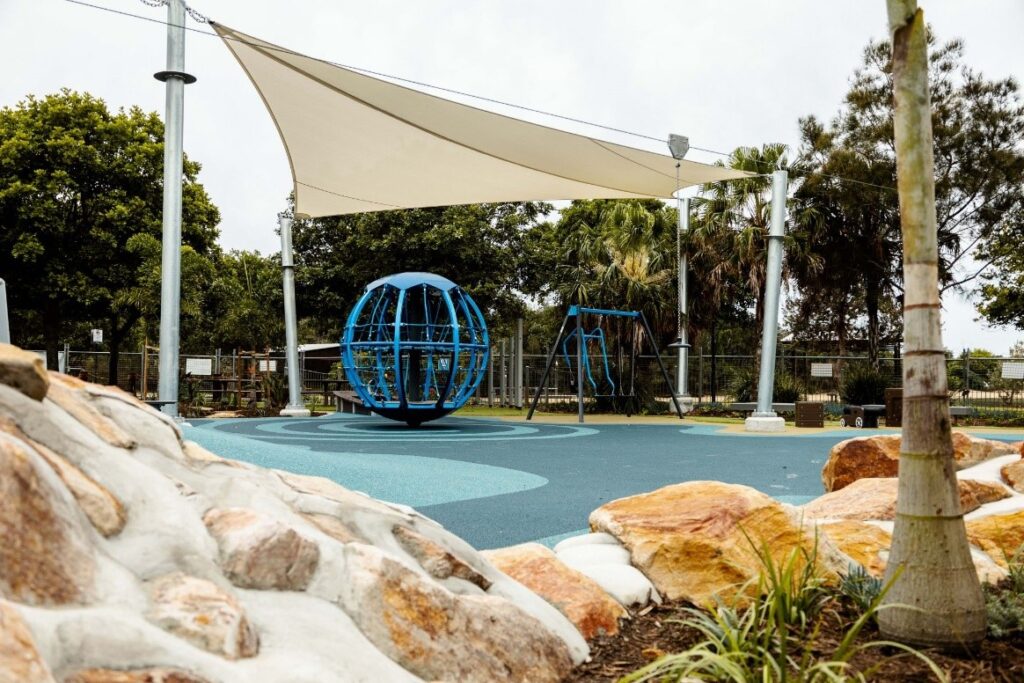YOU ARE HERE:

Environmental & Social Benefits of Outdoor & Commercial Shade Structures in Queensland
Jamie Howard In Shade Structure
In the sun-soaked state of Queensland, Australia, where the golden rays of the sun shines brightly for much of the year, the importance of shade structures extends far beyond mere sun safety. While protecting individuals from the harsh effects of ultraviolet (UV) radiation remains paramount, Commercial shade structures play a multifaceted role in shaping the environmental sustainability and social fabric of Queensland’s outdoor spaces. From mitigating the urban heat island effect to fostering community engagement, these structures serve as vital components in creating healthier, more liveable cities and towns.
Harnessing Environmental Sustainability
Queensland’s subtropical climate brings with it sweltering temperatures and prolonged exposure to the sun, particularly during the summer months. The rise of urbanization further exacerbates these conditions, as concrete jungles absorb and radiate heat, creating what is known as the urban heat island effect. In this context, shade structures emerge as powerful tools for environmental sustainability, offering a range of benefits that extend far beyond their immediate function of providing shade.
One of the primary environmental benefits of shade structures lies in their ability to mitigate the urban heat island effect. By casting shade over outdoor surfaces, such as sidewalks, parking lots, and building facades, these structures reduce solar heat gain and minimize the absorption of heat by urban infrastructure. Car park shade structures are particularly beneficial, protecting vehicles from the sun’s harsh rays while keeping the area cooler for visitors. Consequently, the reliance on air conditioning systems decreases, leading to lower energy consumption and reduced greenhouse gas emissions. In essence, shade structures contribute to the creation of cooler, more energy-efficient urban environments, thereby enhancing the overall sustainability of Queensland’s cities and towns.
Moreover, shade structures play a crucial role in promoting biodiversity and preserving green spaces within urban areas. By providing shaded areas conducive to plant growth, these structures support the establishment of urban forests, pocket parks, and green corridors. Such green spaces not only enhance the aesthetic appeal of the built environment but also serve as vital habitats for native flora and fauna. In doing so, shade structures contribute to the conservation of biodiversity and the promotion of ecological resilience in the face of urbanization and climate change.
Fostering Social Equity and Community Engagement
In addition to their environmental benefits, shade structures play a pivotal role in fostering social equity and promoting community well-being. In a state as diverse and culturally rich as Queensland, access to shaded outdoor spaces is essential for ensuring that all members of the community can participate in public life and enjoy the benefits of outdoor recreation and leisure activities.
Shade structures serve as inclusive gathering spaces where people from all walks of life can come together to socialize, relax, and engage in recreational pursuits. Whether it’s a shaded picnic area in a local park, a covered seating area at a playground, or a sheltered bus stop along a bustling street, these structures provide essential amenities that enhance the quality of life for residents and visitors alike.
Furthermore, Commercial shade structures contribute to the creation of vibrant and resilient communities by facilitating social interaction and fostering a sense of belonging. In shaded public spaces, people have the opportunity to connect with their neighbours, engage in spontaneous conversations, and build social networks that strengthen community bonds. This sense of social cohesion not only enhances the overall liveability of Queensland’s cities and towns but also contributes to greater community resilience in the face of social and environmental challenges.
Conclusion:
In conclusion, shade structures play a multifaceted role in shaping the environmental sustainability and social fabric of Queensland’s outdoor spaces. From mitigating the urban heat island effect to fostering community engagement, these structures offer a myriad of benefits that extend far beyond their immediate function of providing shade. As Queensland continues to grapple with the challenges of rapid urbanization and climate change, the importance of shade structures in creating healthier, more liveable cities and towns cannot be overstated. By harnessing the environmental and social benefits of shade, we can work towards building a more sustainable, inclusive, and resilient future for generations to come.
Share:
Jamie Howard - Director
Co-founder and Director Jamie has been hands-on in the shade and steel industry since leaving school. With over 15 years’ experience in shade, membrane and steel projects, Jamie is excited about the design opportunities shade structures offer in the commercial and industrial sectors. Jamie’s extensive design skills give him a competitive edge in situations with technical design complexity. He has won two personal industry awards for his designs, alongside many company-won awards.

